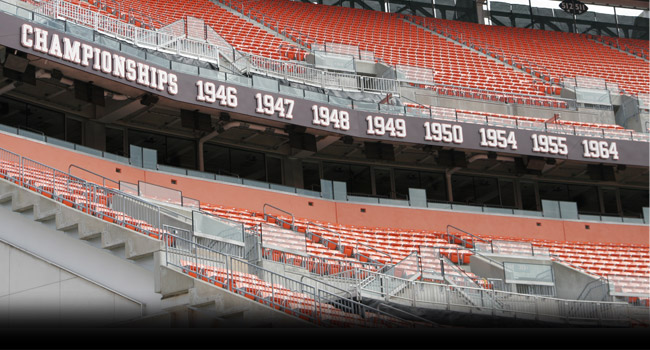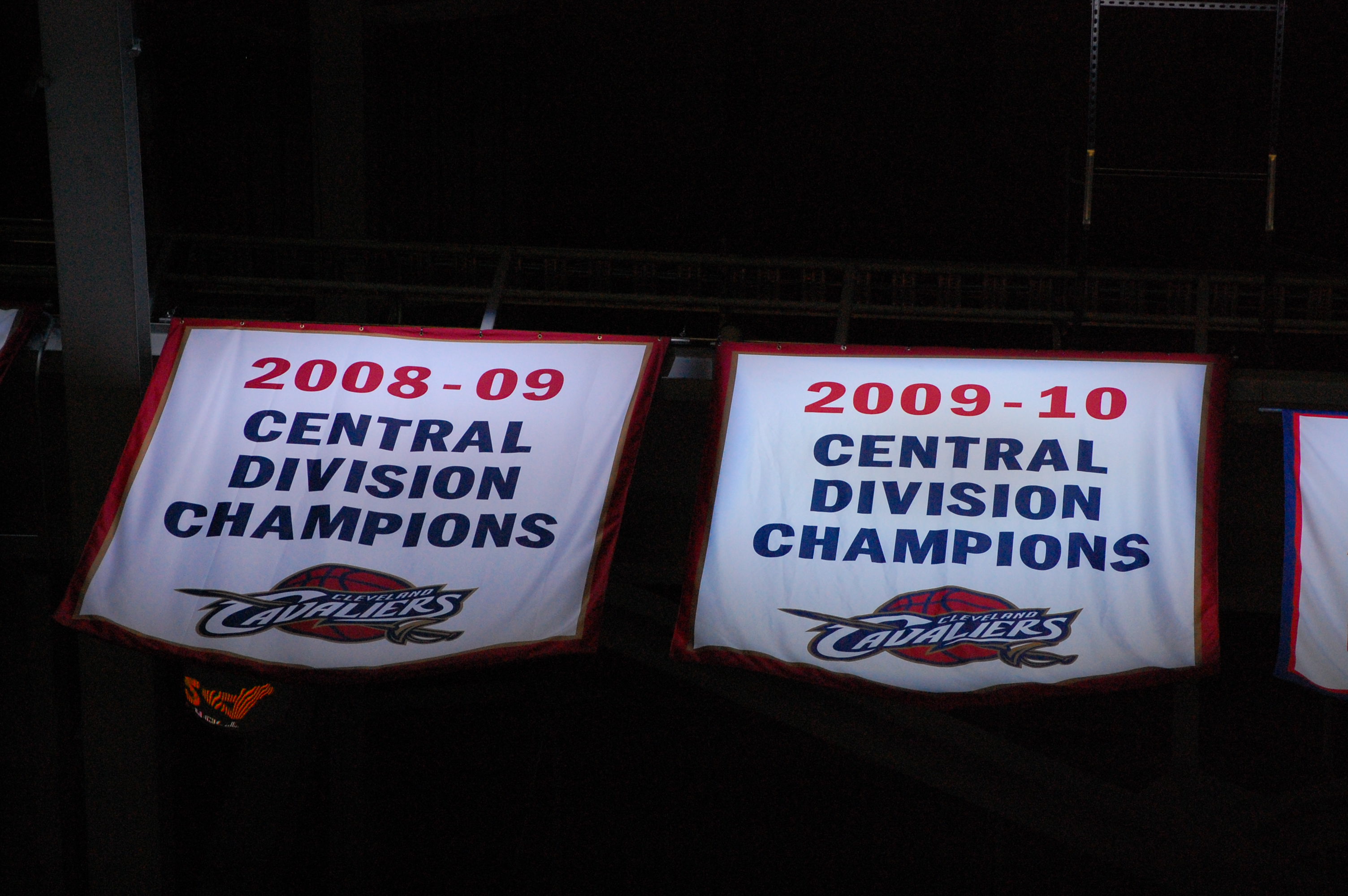 Browns Archive
Browns Archive  Ghosts in the Rafters
Ghosts in the Rafters
 I certainly don’t want to play the role of Eeyore, the gloomy stuffed donkey of the Hundred Acre Wood, but I’m fairly certain the high point of the Browns’ 2012 season has come and gone.
I certainly don’t want to play the role of Eeyore, the gloomy stuffed donkey of the Hundred Acre Wood, but I’m fairly certain the high point of the Browns’ 2012 season has come and gone.
It wasn’t when they drafted Trent Richardson or Brandon Weeden and it wasn’t when “Flying J” Haslam bought the team. It occurred very quietly over the summer on an ordinary day when a couple of Teamsters got up on a ladder with a power drill and some big fiberglass numbers.
As a result, within the Browns’ much-ballyhooed “Ring of Honor,” there finally is a notation of the franchise’s most cherished achievements. In the same font and size as the revered names that make up the Ring are the eight seasons in which the Browns won a league championship:
1946 1947 1948 1949 1950 1954 1955 1964
To which Browns fans gasp, “It’s about time.” For this marks the first time ever - either at CBS or old Municipal - that the Browns’ eight league championships have been enshrined outwardly to spectators inside the ballpark.
Granted, an environmental graphic element like this is a tougher needle to thread in football than basketball or baseball, but for a franchise so enamored with its own history (particularly as a marketing crutch), it’s genuinely hard to believe it took this long to make such an obvious move.
In some ways, the decision to pull the trigger on this took notable courage. Everybody knows it’s been a long time since the Browns were truly good, but now, by precisely pinpointing those moments, you’re allowing all visiting teams, reporters, and fans to do the math. And while some may be impressed by seeing a long string of title years, others will only be able to think, “God, it’s been THAT long?”
So let’s applaud the Browns for going ahead anyway, even if they proceeded with the mindset of “Well, we’re going to embarrass ourselves to everybody else anyway, so we might as well make our fans happy.”
But, as with all things Browns, this decision tends to go off the rails a little bit.
Before we dig into what’s wrong with what they did and the way they did it, let’s take a moment and appreciate what they did right. The style is clean and simple and, like the Ring of Honor itself, simply oozes professionalism and class - two things that are otherwise sorely lacking within this organization.
Yet perhaps that simplicity is part of the problem. The only preamble to this octet of magical seasons is a single word: “Championships.”
It’s not inaccurate and not exactly incomplete, but it opens up some interpretive problems.
First and foremost, these eight seasons don’t encompass every championship the team ever won. There are a handful of division and conference championships that technically qualify. You wouldn’t have, for example, the 1967 Century Division title commemorated up there, but under the brief qualifying characteristic you’ve spelled out, it could be.
Sadly, the same holds true for the five AFC Central championships of the 1980s that Browns fans hold dear to their hearts and remain the last truly good memories associated with this franchise. Much as we’d love to see 1980, 1985, 1986, 1987, and 1989 commemorated somewhere, somehow, here and now is not the place. (And hats off to the Browns for sidestepping that obvious temptation, for that truly would lead to deserved mockery from other NFL teams that have so many division titles you could circle the inner bowl of their stadiums three or four times.)
You also can’t specify those eight years up there by making it “World Championships” or “NFL Championships” because the 1946-1949 titles were in the All-America Football Conference, essentially a minor league at the time.
Which raises the question of whether they should have been included at all. Yes, the Browns couldn’t help the AAFC’s bush-league street cred. They simply won the league they were playing in, just as every NFL team today aspires to, and the AAFC titles do mean something. Just not as much as the four NFL titles that followed.
So if, hypothetically, you took out 1946-1949 from the Ring, you could put “NFL” or “World” as an appropriate descriptor for the remaining four. (And come to think of it, either way, wouldn’t “Champions” be better than “Championships”?)
But what the hell. Rome wasn’t built in a day. Now that they’re up there, tinkering around with them will be a much smaller fish to fry.
And that’s the bottom line, the primary point to take away: they’re finally up there, and that means something.
To many (perhaps most) sports fans, decorative features like this are as meaningless as the Southwest Airlines banner ad within the same sightline. Who cares about what the team has done before? The question is what are they going to do today to keep me entertained as I text three people at once, check Fantasy Football updates on my phone, and play Angry Birds while the game is taking place down on the field.
More than just looking nice, these numbers are signs of respect and appreciation, like hanging old family pictures on the walls of your house. They remind you of your past and what you love. And as you go about the business of the current day, even if things are a complete disaster, you can always glance up at them and feel just a little bit better.
Call them family photos, call them bowling trophies or moose heads, they’re something Browns Stadium desperately needed.
And now that the Browns have finally gotten on board, perhaps it’s time for the Indians to do something similar (God knows they’ve got some thinking to do this winter.) Yes, they’ve had all the franchise’s titles - from the World Series victories to the AL Central cakewalks of the late ‘90s - memorialized in pizza-box sized pennants on the right-field upper-concourse overhang.
While the design is OK and the placement is acceptable, like most things the Indians have tried to do in the past 10 years, it just doesn’t work.
First and foremost, they’re simply too small to read for 75% of the ballpark. Putting it in basic endorsement terminology so that the Indians’ front office can understand - no business would tolerate putting an ad that small anywhere in the ballpark.
(Which, come to think of it, is likely why they’re as small as they are - to leave more room for Progressive Insurance and Cleveland Clinic banners. Maybe they could be combined: “The 1920 Indians’ World Championship - brought to you by FirstEnergy.”)
(Oh my God, that’s really what would happen.)
As they’re currently designed, you might be able to see the year on the pennants, but if you weren’t well-versed in Tribe history, you wouldn’t know what the team had won that season. Apparently backpedaling, they tried to address this by color-coding them - the two world titles are blue pennants, the three pennant winners are yellowish, and the division flags are red - but again, that only means something if you already get it. And if you already get it, you’re already pissed off by how they’re doing this.
That being said, bigger isn’t necessarily better. Let us not go back to the “Era of Champions” episode in which the left-field wall was shellacked with 15-foot letters spelling out the noble achievements of the then-four-year-old Jacobs Field era. As excited as we all were to be able to commemorate anything about Indians baseball at that point, this just made us look silly. Thank goodness Bud Light came along and gave the Indians a bunch of money to make this problem go away.
This year the team painted the championship flags atop the dugouts, which is nice, and certainly better than another obnoxious ad that still can’t pay for a decent free-agent signing, but still not quite right.
 Ironically, the Cavs, who have the least to commemorate, do it best. Four classy, stylish, easy-to-understand banners hang from the rafters in the Q, celebrating their three division titles and lone conference crown. (Wait - didn't I just say commemorating division titles is preposterous? Yes it is. But the Cavs get away with it by making preposterous look good.)
Ironically, the Cavs, who have the least to commemorate, do it best. Four classy, stylish, easy-to-understand banners hang from the rafters in the Q, celebrating their three division titles and lone conference crown. (Wait - didn't I just say commemorating division titles is preposterous? Yes it is. But the Cavs get away with it by making preposterous look good.)
Of course, the very design of basketball venues lends itself to doing this the right way. At the end of the day, every team in every sport is trying to copy the feel of the old Boston Garden, with dozens of colorful but simple title banners floating over the floor. Even for somebody who isn’t impressed by sports history, looking up at those rafters was both impressive and intimidating. You didn’t just have to beat these guys, you had to beat all that history and all those ghosts in the rafters.
Since there’s little that can be done in the short-term about the - ahem - modest state of Cleveland teams in the present, perhaps the best way to at least suggest baseline competence to your fan base is to respect the past the way your fans do. (And, BTW, the best way to do that isn’t cranking out more bobbleheads and having Carlos Baerga sit with Matt & Rick in the booth for an inning.)
So as the Browns prepare to embark on another season seemingly guaranteed to frustrate us, let’s applaud their doing at least one thing right in 2012 and hope that this good decision can lead to even more.
- NBA Announces 2013-2014 Schedule
- Browns Ink Sharknado
- Sharknado A No-Show For Rookie Camp
- Trent Richardson Out Until Training Camp
- Browns Sign Brandon Jackson
- Carrasco Suspended Eight Games
- Browns Add to Wide Receiver Depth with David Nelson
- Browns Need to Learn from Past Draft Mistakes
- Browns Release Chris Gocong and Usama Young
- Browns Missing on Grimes Disappointing, But Not The End
The TCF Forums
- Official- Browns Coach Search/Rumors
HoodooMan (Tuesday, January 21 2014 1:32 PM) - Movies coming out
rebelwithoutaclue (Tuesday, January 21 2014 12:56 PM) - 2015 Recruiting
jclvd_23 (Tuesday, January 21 2014 12:38 PM) - The 2014 Offseason Thread
Larvell Blanks (Tuesday, January 21 2014 12:25 PM) - Chris Grant's first 3 drafts
Kingpin74 (Tuesday, January 21 2014 10:13 AM) - Mike Brown
YahooFanChicago (Monday, January 20 2014 11:15 PM) - 2014 Hoops Hockey Hijinx
jpd1224 (Monday, January 20 2014 4:44 PM) - 2014 Recruiting
jclvd_23 (Monday, January 20 2014 2:26 PM) - Wish List - #4 Pick
Hikohadon (Monday, January 20 2014 1:26 PM) - #1 overall pick Anthony Bennett
TouchEmAllTime (Sunday, January 19 2014 1:28 PM)


